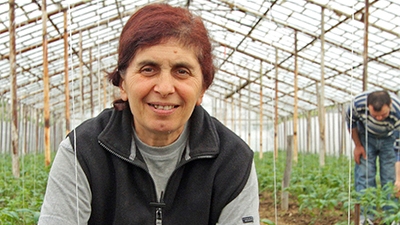This story about Mariam and Emre, two fictional characters, aims to illustrate in a personalized way what is meant by the asset-based approach to understanding shared prosperity.
Mariam and Emre
Mariam lives in in rural Georgia. She has a small plot of land that she inherited from her parents. Along with her children, she uses the land to produce small amounts of agricultural goods to sell in the local market. She holds traditional rights over her land – rights that have been respected for generations, but for which no supporting legal documents exist.
Miriam’s education discontinued after primary school and today she works for three or four months a year in a small grocery store, for a relatively low salary. As female head of the household, she also receives social assistance from the government. Mariam keeps cash savings at home, as is customary in her community, to pay for household needs throughout the year. She has managed to put some extra money aside, hoping to one day open her own grocery store and expand her household’s sources of income.
Emre lives in urban Turkey. He finished high school and today works in a local manufacturing plant. Using a combination of savings and money he inherited from his father, he was able to buy a small apartment, in which he lives and also rents out a room. Emre manages to save part of his salary on a regular basis (his salary has increased recently because of an active government minimum wage policy that has impacted wage negotiations throughout the country). Because of this, he plans to buy a new apartment in which to live and then rent out the entire apartment where he currently lives.
Emre also attends private training courses, for which he pays with a public cash voucher. This training will allow him to become better certified at work, provide opportunities to meet other people working in areas and firms related to his own, and potentially open up new job opportunities in the future.
The market and non-market incomes of Mariam and Emre
Mariam and Emre both generate income from a different combination of assets, intensity of use of these assets, and non-market income sources. Not only has Emre accumulated a higher level of human capital, but he uses it more intensely and obtains a higher return, which has increased because of the active wage policies in his country.
Mariam uses her lower human capital to work her own land and, in return, is able to make extra savings by avoiding the need to hire an additional worker. At the grocery store, she also receives a salary that is relatively high for her education level, mostly because she is trusted to carry out cash transactions in the store and manage the inventory.
Both Mariam and Emre also possess physical capital: land and real estate, respectively. Mariam exploits her land and obtains a return by selling the produce at the market. However, she could use it more intensively if the legal property documents were available, which would give her the chance to use the land as collateral to access credit and start a business to diversify her sources of income.
Emre earns extra income by renting the second room in his apartment. He can accomplish this also by exploiting his social capital: renting to a person from his job network, someone he can trust who is available to carry out such an informal transaction.
In terms of financial capital, Mariam does have savings, but she does not use them intensively; she keeps cash at home, thereby forgoing potential returns from saving in the formal banking sector. Emre has financial capital – his savings – and uses them more intensively by obtaining a return and accumulating to invest in a new apartment.
Mariam also receives non-market income through public social assistance transfers. Emre receives a voucher to pay for his training, and the voucher represents part of his overall income.
Asset accumulation
Mariam attempts to accumulate assets through savings that she keeps at home; she would like to invest in a business in the future. Formalizing the property rights over her land could accelerate this process because she would be able to use her land more intensively, as collateral for a loan.
Emre is investing in his skills, trying to obtain the certification that will enhance his employability in the near future, while also strengthening his networks within the same area of activity. Moreover, he is saving in the bank to also accumulate physical assets by, eventually, acquiring another property where he can live.
Mariam and Emre contribute to overall growth
There are variables that Mariam and Emre cannot control, including the existing level of wages, the level of demand for their skills, and the price of the goods they produce. These are determined by overall macroeconomic performance and may depend on cyclical factors. For example, if the sector in which Emre works sees demand for its products decrease, his situation can change and his plans may be thwarted.
Within this context, however, Mariam and Emre can make decisions that allow them to be productive and contribute to overall growth in their respective countries.
To understand how they can contribute more, become more productive, and achieve the goals they have set for themselves, we need to examine the microeconomic dynamics in terms of their assets, the intensity of use of their assets, and their returns. But, public decisions also matter through a component of non-market income – transfers – that is an important complement to providing income support, and thereby also influences their economic decisions.
Related story: Paving the Way to Shared Prosperity in Emerging Europe and Central Asia

